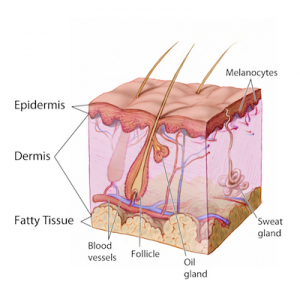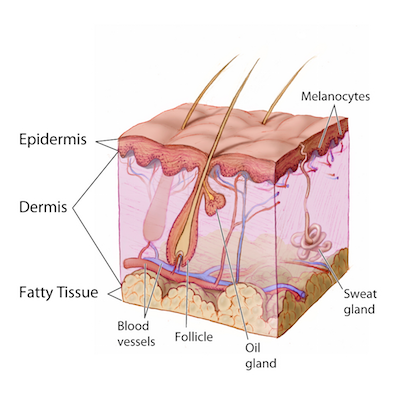Whether they’re from fires, electricity, chemicals or another agent – they’re always serious. In most cases it’s best to call for the paramedics, but 911 only works so well… What can you do for the burn victim until the ambulance arrives?
Remember, personal safety should be the first priority of anyone offering first-aid to a person with burns. Be aware of any ongoing risks of fire, chemicals, or electricity. There may also be risk of toxic fumes or explosion e.g. due to a nearby petrol or gas supply.
Diagnosis
First, it is important to distinguish between mild and serious burns.
The skin is a living tissue composed of three layers, the epidermis (the skin we see) the dermis, (underlying skin) and the subcutaneous tissue (bones, muscle, etc.)
composed of three layers, the epidermis (the skin we see) the dermis, (underlying skin) and the subcutaneous tissue (bones, muscle, etc.)
New names for old injuries
The severity of a burn depends on how deeply it has affected the tissue. There are three categories of burn: superficial, partial thickness and full thickness. They used to be called first-, second- and third-degree burns. And because that’s what they’re called in the real world, that’s what we’ll call them here.
Facial burns, burnt eyebrows or nose hair, and black, charcoal deposits in the mouth or sputum indicate that the airways may be burnt. Seek medical attention immediately.
Superficial or first degree burns:
Minor burns that affect the epidermis are characterized by red, tender and swollen skin.
Acquired:
Touching a hot stove, bumping into someone’s cigarette, light sunburn, etc.
Healing:
First degree burns heal quickly, often lasting no more than three days. “Light” burns on the outer skin are sometimes more serious for children and the elderly, as their skin is thinner.
Treatment of first-degree burns
Drench with water. Hold under a faucet running cool water for about ten minutes. If there is no water available, cover the burned spot with a cool compress or a towel, blanket or piece of clothing. Extremely cold water or ice will not help. Give the victim liquids to avoid dehydration. Administer ibuprofen or acetaminophen* to reduce swelling. Cover the burned area with a bandage or cool cloth, sterilized if possible.
Partial thickness or second-degree burns:
If the burn passes the epidermis into the dermis, the affected area looks red, tan, or white, and might scar. Superficial partial-thickness burns severely affect the first and second layers of skin. Evidence of these are pain and heavy blistering. A second-degree burn often seems wet, because the liquid part of blood, the plasma, seeps out through the damaged skin layers. The skin blisters. The base of the blisters may be red or whitish and filled with a thick, clear fluid. The skin is very sensitive and painful, even to air movement.
Acquired:
Often caused by direct contact with hot liquids or contact with gasoline, kerosene or other chemicals. Second-degree burns can also be caused by a heavy sunburn.
Full thickness or third-degree burns
Often a result of contact with fire, electricity, chemicals or immersion in hot to boiling water, third-degree burns are the most serious, and quite deep, passing the epidermis and the dermis, and penetrating the muscle and bone.
The skin can look a number of shades–blackened, cherry red, dead white, or charred. Often the victim feels no pain because the nerve endings and sensory receptors in the affected skin have been deadened.
Healing:
The destroyed skin does not grow back, and there may be a need to surgically graft new skin. Victims of third-degree burns often have difficulty breathing and hoarse voices.
Treatment of second- or third-degree burns
Call 911. Try to elevate the victim and keep the burned areas clean. Get the victim to a sink or bathtub and put the burned area under cool running water for ten minutes. Do not remove clothing stuck to skin.
Do not:
– break or drain any blisters. Burns are perfect growth mediums for bacteria, which can lead to infection so always keep your dressings and bandages clean and dry.
– give the victim liquids to drink.
To help prevent shock, make sure the victim is lying flat and elevate the feet about a foot in the air.
Electrical burns:
Electrical burns can cause neurologic dysfunction and cardiac dysrhythmia as well as severe burns. Do not touch the victim.
Unplug the appliance at the outlet or if the appliance is burning, cut off at the power switch or circuit breaker. If you are not able to cut off the power use a non-conductive item such as a piece of wood (broom handle), rolled up newspaper or dry blankets to separate the victim from the burning electricity.
Water kills
Be very careful if the electrical item is in water as water conducts electricity. Electrical injuries account for approximately 20,000 emergency department visits and 1000 deaths per year. Children account for 20% of these. Watch children around uncovered outlets; they may stick something in them. Very small children may try to suck on power cords.
Signs and treatment of electrical burns
Check for signs of shock: clammy, cold skin; faintness; rapid, weak pulse; paleness; irregular breathing. If one or more signs are present, cover with a blanket and elevate the legs. Do not move the victim. If the victim is not breathing, apply mouth-to-mouth resuscitation, or if there is no pulse, do cardiopulmonary resuscitation (CPR) Keep the victim covered and warm, keep the head low, and call 911.
If the victim is conscious, and not in shock, treat the burned area with a sterile, dry dressing and take to the emergency room.
Chemical burns
Chemical burns can be caused by many substances, such as strong acids, drain cleaners (lye), paint thinner and gasoline. Usually, you are aware of the burn and its cause. But sometimes you may not immediately recognize a burn caused by a milder chemical. As with some sunburns, the pain and redness may develop hours after the exposure.
If you have an immediately recognized chemical burn
Remove the chemical causing the burn while protecting yourself. For dry chemicals, brush off any remaining material. Wear gloves or use a towel or other suitable object, such as a brush.
Remove contaminated clothing or jewelry to prevent further burning.
Rinse the burn immediately. Run a gentle, steady stream of cool tap water over the burn for 10 or more minutes. A shower may be an effective way to do this. Always protect your eyes.
Loosely apply a bandage or gauze.
If needed, take an over-the-counter pain reliever, such as ibuprofen (Advil, Motrin IB, others), naproxen sodium (Aleve.)
Consider a tetanus shot. Make sure that your tetanus booster is up to date. Doctors recommend people get a tetanus shot at least every 10 years.
If you have a possible chemical burn
Make sure that any contaminated clothing or jewelry is no longer in contact with your skin.
Rinse the burn if you think some of the chemical is still on your skin.
Loosely apply a bandage or gauze.
If needed, take an over-the-counter pain reliever, such as ibuprofen (Advil, Motrin IB, others), naproxen sodium (Aleve) or acetaminophen (Tylenol, others).
Consider a tetanus shot. Make sure that your tetanus booster is up to date.
When to seek emergency care
The person shows signs of shock, such as fainting, pale complexion or very shallow breathing.
The chemical burn penetrated through the first layer of skin and the burn covers an area more than 3 inches (about 8 centimeters) in diameter.
The chemical burn encircles a limb or involves the eyes, hands, feet, face, groin or buttocks, or a major joint.
The Squirrel says: If you’re unsure whether a substance is toxic, call Poison Help at 800-222-1222 in the United States. If you seek emergency medical help, take the chemical container or the name of the chemical with you to the emergency department.
Did you know that acetaminophen taken in excess could destroy your liver? An overdose may not kill you straight away but you will almost certainly die of liver failure within days of a massive intake of this drug. Administer it carefully, especially to young children.
First Aid is an important life skill and invaluable in an emergency. Every adult should have the basic first aid skills – preferably learned at a reliable institution such as the American Red Cross.

